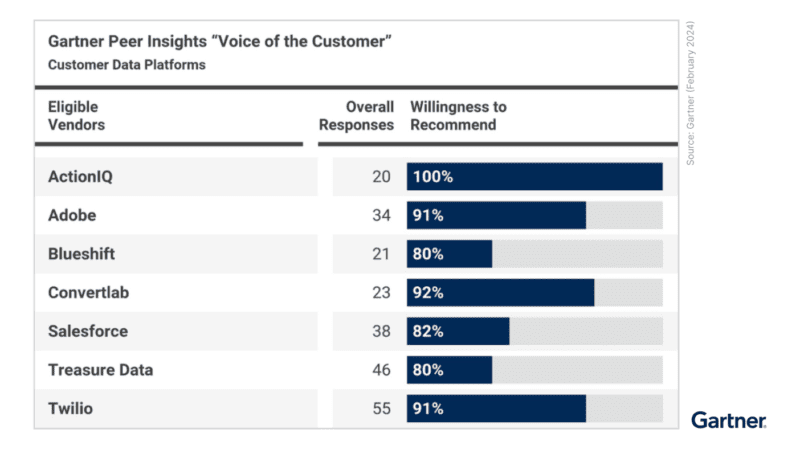CX in Action: Creating a Customer 360

The CX in Action blog series is designed to help you upgrade your customer experience strategy with examples from leading enterprise brands. Check out our post on creating a customer 360 below.
The best customer experiences are built on a comprehensive view of your audiences, otherwise known as a customer 360. Unified customer profiles are the foundation of everything that follows, including audience segmentation, journey orchestration and real-time experiences.
While creating a detailed profile for a single customer may sound simple enough, doing it for every customer (and doing it well) is a different matter. It’s easy for brands to feel overwhelmed — like they can’t extract value from their customer data until they have a perfect 360-degree view of their entire customer base.
But that’s not the case. Building a customer 360 is an open-ended process that’s always in motion — and it’s one that will change as new customer data and channels enter the picture.
The goal is to continually improve your customer view over time, not wait to take action on the insights you already have. This means consistently unifying customer data, resolving customer identities and enriching customer profiles — and, of course, providing direct access to data across teams and systems.
Read on to see how leading enterprise brands do just that to create a customer 360.
Hear how Autodesk breaks down data silos in the video below:
CX in Action: Creating a Customer 360
Unifying Customer Data
The first step is combining historical and real-time data to create a unified profile of your customers. But just as important is deciding where this data lives and who has access to it, as customer insights aren’t much use if they’re under lock and key.
That’s why software company Autodesk created a “common centralized platform to keep customer data in one place and give all departments the big-picture overview” with their customer data platform (CDP), according to Autodesk’s Senior Director of Enterprise Engagement Tzvetana Duffy.
Not only does creating a single source of truth help organizations avoid siloed and fragmented data, it allows technical teams to maintain control over how data is accessed and used across systems to improve data security and privacy.
And as cosmetics retailer e.l.f. Beauty can attest to, giving business teams an accessible view of customers goes a long way toward making sure opportunities don’t slip through the cracks.
“We had a ton of consumer data … and we just had our data in a lot of different systems and reported in a lot of places,” said e.l.f. Beauty’s Director of Global CRM & Customer Growth Brigitte Barron. “To really get to that next level, we had to bring all that data together in one system to unlock more opportunities and more insights.”
To break down data silos without months of upfront scoping and engineering work, brands need the ability to ingest data as-is from any source and fully manage, monitor and access it within their CDPs immediately. And since high volumes of data will likely be added over time, persistent and unlimited customer data storage is key.
Customer data can then be integrated with preferred execution systems — whether for marketing, sales or customer service — across channels and in any volume from a single solution, traveling seamlessly and at scale to downstream technologies.
And by using prebuilt connectors, organizations can add new channels whenever they need to without relying on IT to build and maintain integrations.
Resolving Customer Identities
Bringing data together into a single customer view or customer 360 is one thing — making sure it’s accurate is another. That’s why brands should work to get rid of duplicate profiles and resolve anonymous customer identities.
By applying machine learning-powered matching techniques to customer data and working with data partners to augment and complement existing data, organizations can manage and resolve identities across anonymous and known customers.
This helps brands like e.l.f. Beauty understand exactly who they’re talking to and personalize customer experiences accordingly using their first-party data — something that’s become much more critical in the face of third-party cookie deprecation and the loss of anonymous identifiers.
“First-party data is critical for so many reasons, but I think an obvious one … is everyone knows eventually we’re going to have third-party cookies going away,” Barron said. “Having successful paid media campaigns is going to depend on having that quality first-party data.”
Learn how Albertsons Companies strengthens customer profiles in the video below:
Enriching Customer Profiles
Your customers aren’t stagnant, so their profiles shouldn’t be either.
To keep customer profiles as valuable and up to date as possible for audience segmentation and experience orchestration, organizations need the ability to define new customer attributes on the fly from all their customer data.
Creating and managing customized profile attributes across any data set with an easy-to-use self-service interface helps brands eliminate the time-consuming (and costly) IT work required to translate data into the language of the business. That way, non-technical users at brands such as grocery retailer Albertsons Companies can easily tap into all available customer data to create and activate new attributes in minutes.
“[W]e are now able to have a unified customer profile platform that combines traditional transaction data and behaviors, all focused on the customer at the center,” said Albertsons Companies’ Director of Marketing & Advertising Platforms Sankett Deshpande. “We can now truly get a deep understanding of customer behavior intent to make every interaction the most meaningful experience for our customers where they are.”
Creating a customer 360 is fundamental to CX strategy, but keep in mind that obtaining a 360-degree view of your customer base is not a one-and-done affair. It’s a continuous practice you’ll need to build on over time.
It’s also only one piece of the puzzle. The value of customer data is in what you do with it, from hyper-segmenting audiences to crafting sophisticated customer journeys. So whether you buy a CDP or build one in house, remember that creating a customer 360 is not the end goal — using it to power customer experience is.
Learn More About Creating a Customer 360
Get in touch with our experts to discover how you can create a customer 360 or build on it using the AIQ CX Hub.





